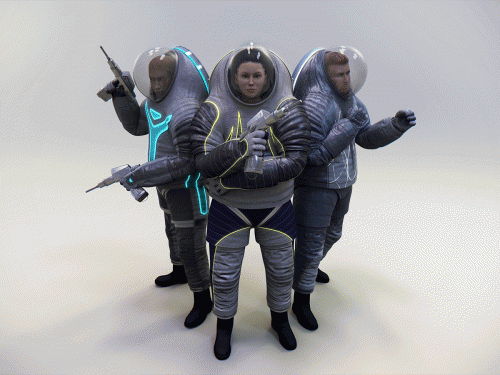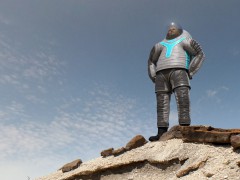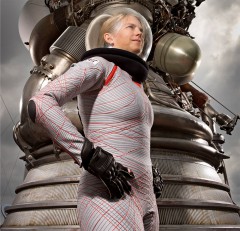
If you’ve ever wondered what the latest fashion trends are for NASA astronauts, then here is your answer. For the first time in nearly 30 years, spacesuits for American astronauts are being given a complete makeover for the 21st century, as shown this week in Wired. These are not your typical Mercury, Apollo, or Shuttle-era spacesuits that we are used to seeing, so liking them or not might be a very subjective choice.
The revamping of the spacesuit designs, called the Z-2 Spacesuit, is being done by NASA’s Amy Ross, who leads the design process for the advanced pressure garment technology. The spacesuit is being developed specifically for planetary exploration, such as the Moon and Mars. This makes them a successor primarily to the old Apollo design, since planetary spacesuits are created with those unique kinds of problems and challenges in mind, different from say the spacesuits worn by astronauts on the space station or in the former space shuttle.

Even though a specific timetable for a Mars mission isn’t known yet, the Z-2 Spacesuit is being designed now for just such a mission, as well as possible earlier trips back to the Moon. Each kind of destination poses its own environmental challenges. As Ross explains: “It all depends on where you’re going and what you’re doing. Each spacesuit is tailored for the mission, what tasks the astronauts will be performing, where they’ll be doing them, the planetary microgravity, how hot or cold it is, how many times they’ll be doing it, and so on.”
The Z-2 may look quite different from its predecessors, but there isn’t really one big change, per se; rather it incorporates a lot of smaller innovations that make it well-equipped for the needs that lay ahead in the next couple decades. “If you need to crawl under a rover to change its oil, you should be able to,” said Ross. “If we ask you need to jog up Olympus Mons, you should be able to do that in the same suit.” The focus is more on material and manufacturing advances, which may not sound as exciting but, of course, are extremely important.
Perhaps the biggest change is the Suitplate Interface Port, where an astronaut can hook up to a vehicle directly using a rigid shell on the back of the suit, instead of having to go through a separate airlock. A great idea, and the same port also serves as an attachment point for the Portable Life Support System. The PLSS is the backpack which provides oxygen, thermal regulations, and other essential functions to the astronauts.
The Z-2 prototype is expected to be delivered and tested in November 2014. It’s certainly possible it will go through additional design changes before being put into use in the 2020s or 2030s. There are actually three different versions of the Z-2 design being proposed, coming from students at Philadelphia University and engineer Shane McFarland. The final design is due to be selected by the end of April.


How does the Z-2 compare to previous suits used by astronauts? The old Mercury-era suits were known for their silvery appearance, while the Apollo ones were basically white. The new Z-2 pro type is distinctly more colorful with a unique Y-shape pattern on the front. The clear, roundish “bubble-type” helmet is a nice touch. Like the Mercury and Apollo suits, it is still rather bulky but more “sci-fi” in appearance—note also the bright ribbings (electroluminescent wires) which can self-illuminate in the dark, which is kind of cool. All told, it’s a dramatic change from the older suits of yesteryear.
That said, the Z-2 is obviously still not the really cool tight and skin-fitting bodysuit often imagined in science fiction. Those types of advanced suits may be a ways off yet, although the concept is being pursued. Take a look at this prototype being developed by Dana Newman of MIT. That’s getting a lot closer to the body-fitting ideal we tend to think of for future explorers. Such a suit would be much better to maneuver around in, which, of course, would make the exploration process that much more efficient.
To become reality, however, will require more advances in material science to get them so slimmed-down. But who knows? Perhaps in a few decades, these more “fashionable” and futuristic garments will be displayed on a Martian “red carpet.”
Want to keep up-to-date with all things space? Be sure to “Like” AmericaSpace on Facebook and follow us on Twitter:@AmericaSpace




Brilliant article. I thought the first picture was straight from a video game for a full five minutes before realizing that they were the new suits!
good looking for a trip to space!
The Suitplate Interface Port should work quite well in eliminating the problem encountered by Apollo lunar expeditions when lunar regolith on pressure suit boots, gloves, arms, legs, etc. was brought into the lunar module. The regolith was not the nice smooth sand and dust of Earth which is worn and polished by geological processes of wind and water, but was coarse, sharp material created by thousands of years of micrometeorite bombardment of rocks. Such regolith obviously was not good for camera lenses, valves, delicate equipment, or human lungs. An effective way to keep such materials outside of the spacecraft is a great idea. NASA genius strikes again!
I like the guy on the top left with the cordless screwdriver. I guess they will be hanging sheetrock on the Moon and Mars.
Great article but why a grey suit for lunar exploration?